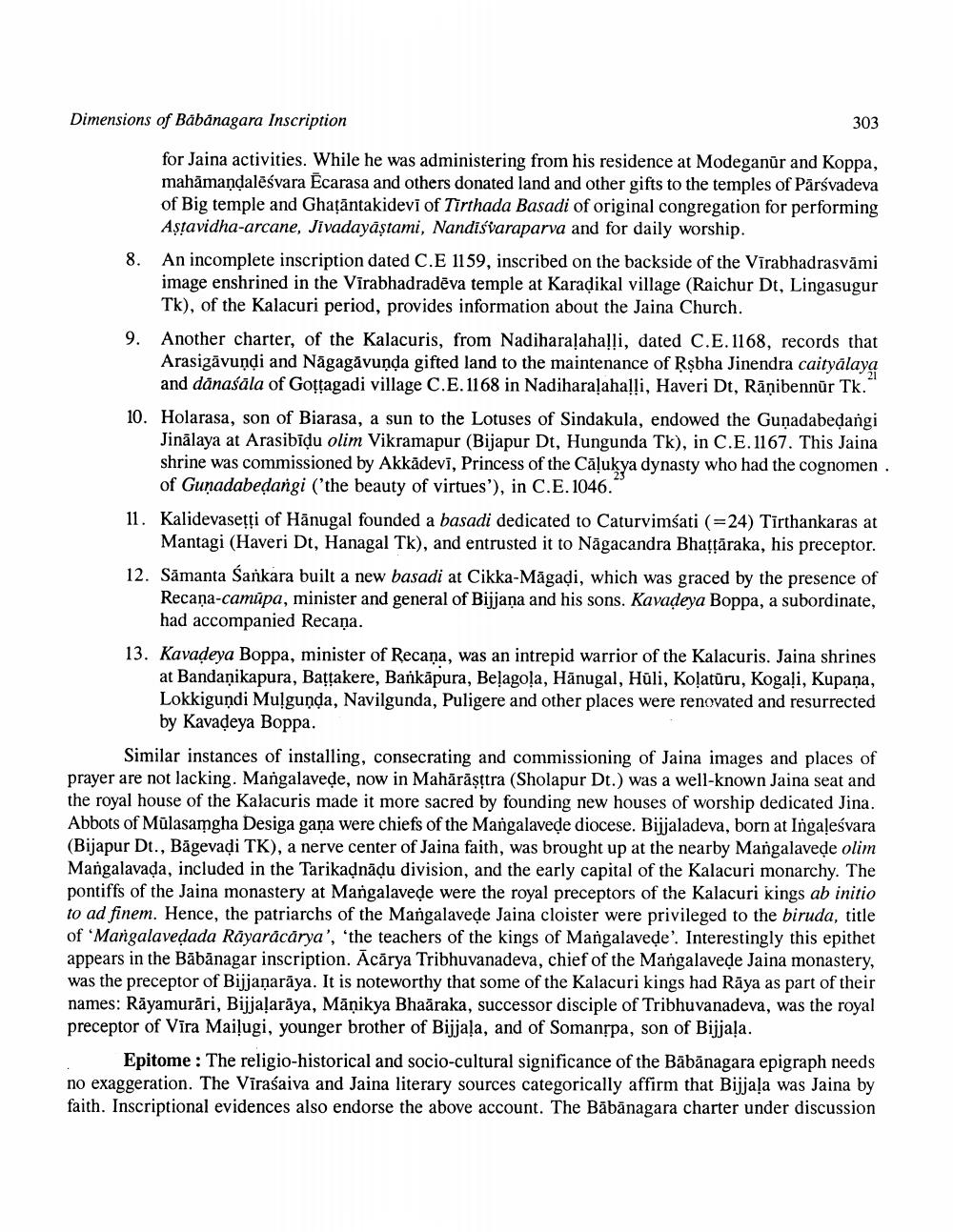________________
Dimensions of Babanagara Inscription
303
for Jaina activities. While he was administering from his residence at Modeganür and Koppa, mahamandalēśvara Ēcarasa and others donated land and other gifts to the temples of Pārsvadeva of Big temple and Ghatāntakidevi of Tirthada Basadi of original congregation for performing
Aștavidha-arcane, Jivadayāștami, Nandisvaraparva and for daily worship. 8. An incomplete inscription dated C.E 1159, inscribed on the backside of the Virabhadrasvāmi
image enshrined in the Virabhadradēva temple at Karadikal village (Raichur Dt, Lingasugur
Tk), of the Kalacuri period, provides information about the Jaina Church. 9. Another charter, of the Kalacuris, from Nadiharaļahalli, dated C.E. 1168, records that
Arasigāvundi and Nāgagāvunda gifted land to the maintenance of Rşbha Jinendra caityalaya
and danaśāla of Gottagadi village C.E. 1168 in Nadiharalahalli, Haveri Dt, Rāņibennur Tk. 10. Holarasa, son of Biarasa, a sun to the Lotuses of Sindakula, endowed the Gunadabedangi
Jinālaya at Arasibidu olim Vikramapur (Bijapur Dt, Hungunda Tk), in C.E. 1167. This Jaina shrine was commissioned by Akkādevī, Princess of the Cāļukya dynasty who had the cognomen.
of Gunadabedangi ('the beauty of virtues'), in C.E.1046. 11. Kalidevasețți of Hānugal founded a basadi dedicated to Caturvimśati (=24) Tīrthankaras at
Mantagi (Haveri Dt, Hanagal Tk), and entrusted it to Nāgacandra Bhatțäraka, his preceptor. 12. Samanta Sankara built a new basadi at Cikka-Māgadi, which was graced by the presence of
Recaņa-camūpa, minister and general of Bijjana and his sons. Kavadeya Boppa, a subordinate,
had accompanied Recaņa. 13. Kavadeya Boppa, minister of Recaņa, was an intrepid warrior of the Kalacuris. Jaina shrines
at Bandaņikapura, Baţtakere, Bankāpura, Beļago!a, Hānugal, Hüli, Koļatūru, Kogali, Kupana, Lokkigundi Muļgunda, Navilgunda, Puligere and other places were renovated and resurrected
by Kavadeya Boppa.
Similar instances of installing, consecrating and commissioning of Jaina images and places of prayer are not lacking. Mangalavede, now in Mahārāșttra (Sholapur Dt.) was a well-known Jaina seat and the royal house of the Kalacuris made it more sacred by founding new houses of worship dedicated Jina. Abbots of Mülasamgha Desiga gana were chiefs of the Mangalavede diocese. Bijjaladeva, born at Ingaļeśvara (Bijapur Dt., Bägevadi TK), a nerve center of Jaina faith, was brought up at the nearby Mangalavede olim Mangalavada, included in the Tarikanādu division, and the early capital of the Kalacuri monarchy. The pontiffs of the Jaina monastery at Mangalavede were the royal preceptors of the Kalacuri kings ab initio to ad finem. Hence, the patriarchs of the Mangalavede Jaina cloister were privileged to the biruda, title of 'Mangalavedada Rāyarācārya', 'the teachers of the kings of Mangalavede. Interestingly this epithet appears in the Bābānagar inscription. Acārya Tribhuvanadeva, chief of the Mangalavede Jaina monastery, was the preceptor of Bijjanarāya. It is noteworthy that some of the Kalacuri kings had Rāya as part of their names: Rāyamurări, Bijja!arāya, Māņikya Bhaāraka, successor disciple of Tribhuvanadeva, was the royal preceptor of Vīra Maiļugi, younger brother of Bijjala, and of Somanộpa, son of Bijjaļa.
Epitome : The religio-historical and socio-cultural significance of the Bābānagara epigraph needs no exaggeration. The Vīrasaiva and Jaina literary sources categorically affirm that Bijjaļa was Jaina by faith. Inscriptional evidences also endorse the above account. The Bābānagara charter under discussion




